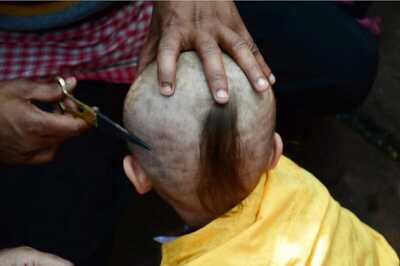
views
It’s the festive time in India! After celebrating Ganesh Chaturthi in September 2023, everyone is now getting ready for Navratri. This year, Navratri starts on October 15 and ends on October 24. Different parts of India have their own special ways of celebrating Navratri, and the food people eat during this time also changes from place to place. But what’s common among all is the tradition of fasting during these nine days.
Some people follow a special diet called the Sattvic diet during Navratri. Many others fast to show their love for the goddess and only eat after praying to Goddess Durga. This fasting starts on the first day of Navratri and goes on till the ninth day. The foods allowed during this fast are very specific. Even if the Sattvic diet is just vegetarian, the Navratri fasting rules are even stricter. During the fast, almonds are a favoured choice. Not only are they nutritious on their own or as additions to dishes, but they also provide sustained energy; almonds have satiating properties making them ideal for fasting periods. If you’re thinking of fasting during Navratri, Ritika Samaddar, Regional Head-Dietetics, Max Healthcare, Delhi shares what you can and can’t eat.
Do’s of Navratri fasting
- Healthy snackingNourish yourself with nuts like almonds. They can be enjoyed raw or incorporated into dishes. Almonds are satiating and can curb hunger for extended periods. In fact, eating almonds can also help with weight loss, something many people are keen on. Almonds are easy and quick to flavour and go with just about any Indian masala/ Mix almonds with your favourite flavours to create healthy, and yet tasty snacks preferred by the family.
- Restricted Veg or Sattvic Diet Embrace ‘sattvic’ foods, which embody purity and aid in fostering a serene and positive mindset. During a Navratri fast, fresh fruits, dairy products, nuts like almonds and select vegetables can be included.
- Choose Specific floursWheat and regular rice are avoided during Navratri fasting. It’s advisable to incorporate special flours like ‘kuttu ka atta’ (buckwheat flour), ‘rajgira’ (amaranth), and ‘singhara’ (water chestnut flour) for culinary preparations.
- Include Dairy ProductsIncorporate milk, curd, paneer, and unsalted butter during Navratri fast. Traditional dishes like ‘vrat ke chawal ka kheer’ made with barnyard millet are popular choices.
- Use Rock SaltWhen cooking, substitute regular salt with ‘sendha namak’ (rock salt), the preferred choice during fasting.
By adhering to these guidelines, one ensures that the Navratri fast aligns with cultural and traditional principles, fostering both physical well-being and spiritual enrichment.
Dont’s of Navratri fasting
- Avoid Regular SaltInstead of common iodized salt or table salt, prefer ‘sendha namak’ (rock salt), which aligns with the traditional fasting guidelines and is believed to be purer for religious observances.
- Avoid Grains and LentilsSteer clear of everyday grains like rice and wheat. Lentils, too, are generally avoided to keep the body light and aid in spiritual awakening during Navratri.
- Avoid Onion and GarlicTypically considered ‘tamasic’ (inducing lethargy), both onion and garlic are avoided as they are believed to distract from spiritual progress.
- Avoid Meat and EggsNavratri is a period of vegetarianism. Hence, all forms of meat, poultry, fish, and eggs are set aside to maintain the sanctity of the fast.
- Avoid Processed and Fermented FoodsFermented items, including many bakery products containing yeast, are eschewed. These are believed to affect the balance of the body’s energies during this sacred time.
Happy Navratri!!

















Comments
0 comment